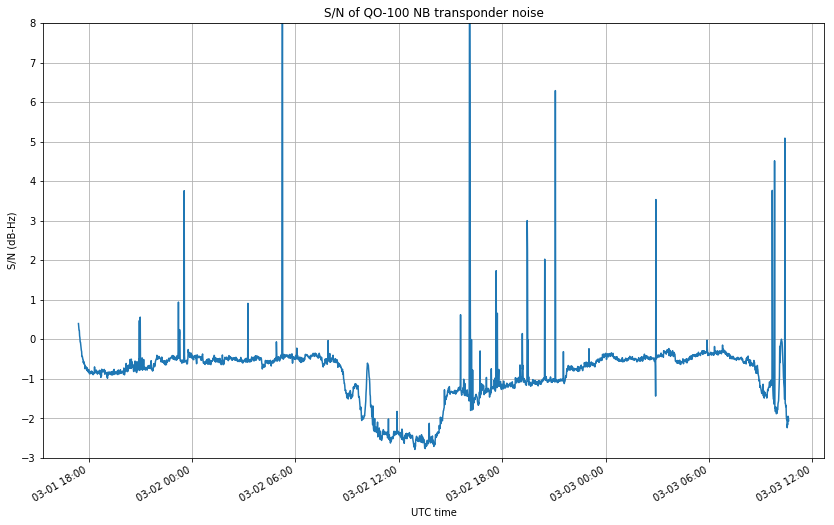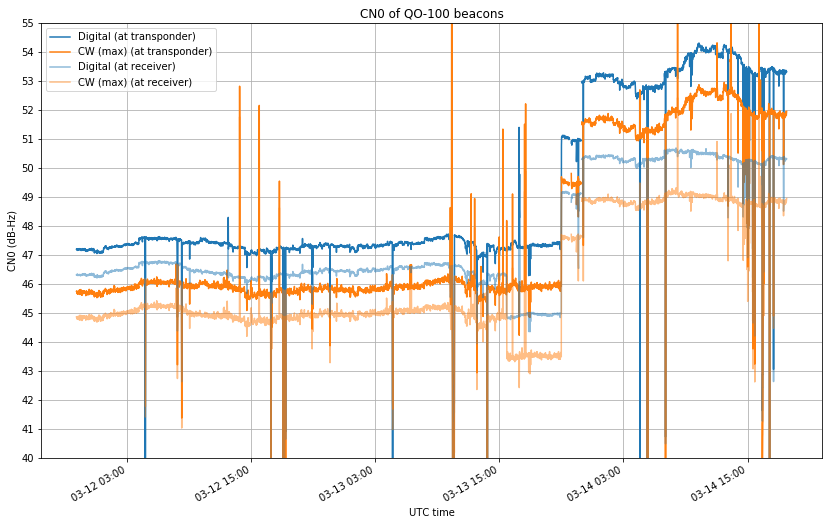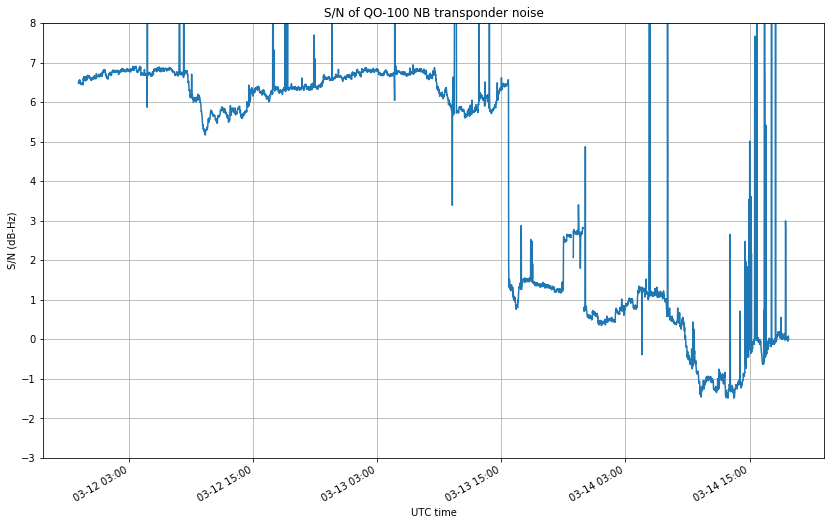Yesterday, AMSAT-DL announced that the narrowband transponder of QO-100 was under maintenance and that some changes to its settings would be made. This was also announced by the messages of the 400baud BPSK beacon. Not much information was given at first, but then they mentioned that the transponder gain was reduced by 6dB and a few hours later the beacon power was increased by 5dB.
Since I am currently doing continuous power measurements of the transponder noise and the beacons, when I arrived home I could examine the changes and determine using my measurements that the transponder gain was reduced by 5dB (not 6dB) at around 15:30 UTC, and then the uplink power of the beacons was increased by 5dB at around 21:00 UTC, thus bringing the beacons to the same downlink power as before. In what follows, I do a detailed analysis of my measurements.
First off, I will start by reviewing the power measurements I did with my old 95cm dish. In that post, I only considered measurements of the beacons (plus transponder noise and system noise) in a 2kHz bandwidth, and also of transponder noise (plus system noise) in a 2kHz bandwidth. The transponder noise was taken by measuring 3kHz below the BPSK beacon.
The problem with that study was ignoring system noise. In a very old post, I explained the rule of thumb that when one has several noise sources and one of these sources raises the total noise by 10dB or more, then one can ignore the remaining sources. However, this 10dB rule is important. If the noise doesn’t increase by more than 10dB, then the other sources shouldn’t be ignored.
In the case of receiving the QO-100 transponder we have two noise sources: the system noise (or receiver noise), and the noise of the transponder itself. If the noise hump of the transponder (composed of transponder plus system noise) is 10dB or more over the system noise (taken for instance, at other nearby frequencies), then the system noise can be ignored. However, one needs a rather large dish to have such a level of transponder noise, and that was clearly not my case.
Also, I didn’t have any measurement of my system noise. I performed a quick measurement by using the same measurement script and tuning the LimeSDR 1MHz below its usual frequency. Since the noise hump of the transponder is approximately 1MHz wide, this tunes to to frequencies completely free of any transponder noise. Using the results of this measurement, I have calibrated the remaining measurements with respect to my system noise.
The figure below shows the raw power measurements (of signal plus noise in 2kHz bandwidth), normalized with respect to my system noise in 2kHz bandwidth. One can see that my transponder noise is only 3dB at most.

Then we compute the CN0 of the beacons properly. Two CN0 calculations can be done: the CN0 at the transponder (the CN0 of the signal on top of transponder noise as it is transmitted from the satellite), and the CN0 at my receiver (the CN0 of the signal on top of both transponder noise and my receiver noise). Of course, the CN0 at the transponder will be a few dB larger than the CN0 at my receiver. The difference gives how much degradation I have for not having enough dish gain (or a lower receiver noise).
These are computed as follows. We denote by \(P_B\), \(P_T\) and \(P_S\) the power measurements of the beacon (plus noise), transponder noise (plus system noise), and system noise, respectively. Then the CN0 at the transponder can be computed as\[C/{N_0}_T = \frac{P_B-P_T}{P_T-P_S},\]and then CN0 at the receiver can be computed as \[C/{N_0}_R = \frac{P_B-P_T}{P_T}.\]
The results of these calculations are shown in the figure below. We see that the digital beacon has a CN0 of 48dB at the transponder, and that I have a degradation of 3.5dB.

Another interesting measurement is that of transponder noise, in relation to system noise. This is computed as\[N_T = \frac{P_T – P_S}{P_S}.\]Here I see a transponder noise of around -1.5dB, meaning that much can be gained by going to a better dish (in my case, the dish wasn’t properly focused).

With these changes to my calculations in mind, I have now processed my power measurements with the new dish, which include the changes to the transponder settings done yesterday. The raw power measurements are shown below.

We see that at a certain moment there is a drop in both the transponder noise and the beacon power. Until doing the calculations carefully, I noted that the transponder noised had decreased less than the beacons, and wondered whether the uplink beacon power had been changed. By doing the calculations properly we can see that this moment corresponds to the drop in transponder gain, and that both the beacon power and the transponder noise power decrease by 5dB.
After this, we see an increase in the power of the beacons, which return to the power they had in previous days. If you observe carefully you will note that the transponder noise also increases by 1dB. The reason for this is the phase noise of the beacons, which is now more noticeable after the increase in beacon power. Thus, the frequency of 3kHz below the BPSK beacon is no longer an appropriate place to measure transponder noise, as the measurements are influenced too much by the phase noise of the beacons.
Therefore, when I noticed this, I changed my measurement frequency of the transponder noise to 50kHz above the CW beacon, which is not contaminated by any phase noise, and is often clear of any signals. This change can be seen as a drop in the transponder noise power measurement.
Now we turn to the study of the CN0 of the beacons. We see that before the changes done yesterday, the CN0 of the BPSK beacon at the transponder is between 47 and 48dB, which matches the results obtained with the old dish, despite the fact that the gain of the dish has changed by around 6dB. However, the degradation with the new dish is only 1dB.
After the drop in transponder gain, the CN0 of the beacons at the transponder remains more or less equal. This confirms that the change in transponder settings has only affected its gain. However, since the transponder noise power has decreased, my degradation has now increased to 2dB (in fact this measurement is contaminated by the phase noise of the beacons, and the degradation should be 2.5dB).
After the beacons increase in power and I change the transponder noise measurement frequency, we see that the CN0 of the beacons at the transponder has increased by 5.5dB (and note that the degradation is 2.5dB).

Finally, we see that before the drop in transponder power, I had between 6 and 7dB of transponder noise (compared to my system noise), while after the change I have between 1 and -1dB of transponder noise.

The calculations and data used in this post can be found in this Jupyter notebook.
One comment